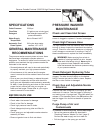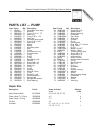
Use the wire included in the kit (Figure 17) or a
small paper clip to free the foreign material clogging
or restricting the nozzle.
Remove additional debris by back flushing water
through the nozzle extension (Figure 18). Back flush
between 30 to 60 seconds. Turn the nozzle
extension to stream spray and move the nozzle from
low to high while flushing.
Reinstall the nozzle into the nozzle extension. Do
Not overtighten.
Reconnect the nozzle extension to the spray gun.
Reconnect the water supply, turn on the water, and
start the engine.
Test the pressure washer by operating with nozzle in
the high and in the low positions.
ORing Maintenance
Through the normal operation of your pressure
washer, orings are used to keep the connections of
the hoses and spray gun tight and leakfree. These o-
rings may become worn or damaged.
Provided with your pressure washer is an ORing
Maintenance Kit which includes replacement o-rings,
rubber washer and water inlet filter. Refer to the
instruction sheet provided in the kit to service your
units o-rings. Note that you will not use all of the parts
in the kit.
To remove a worn or damaged oring:
Use a small flathead screwdriver to get underneath
the o-ring and pry it off.
ENGINE MAINTENANCE
See the engine owners manual for instructions on
how to properly maintain the engine.
PREPARING THE UNIT FOR
STORAGE
Water should not remain in the unit for long periods of
time. Sediments or minerals can deposit on pump
parts and freeze pump action. If you do not plan to
use the pressure washer for more than 30 days, follow
this procedure:
1. Flush detergent siphoning tube by placing the filter
into a pail of clean water while running pressure
washer in low pressure mode (adjustable nozzle in
the forward position). Flush for one to two
minutes.
2. Shut off the engine and let it cool, then remove all
hoses. Disconnect spark plug wire from spark
plug.
3. Empty the pump of all pumped liquids by pulling
the recoil handle about 6 times. This should
remove most of the liquid in the pump. Insert
detergent siphoning tube into clip on handle.
NOTE: To protect the unit from freezing temperatures,
draw RV antifreeze (non-alcohol) into the pump by
pouring the solution into a 3-foot section of garden
hose connected to inlet adapter and pulling recoil
handle twice.
4. Store unit in a clean, dry area.
Storing the Engine
See the engine owners manual for instructions on
how to properly prepare the engine for storage.
Generac Portable Products 2,300 PSI High Pressure Washer
13
Figure 18 Backflushing the Nozzle


















